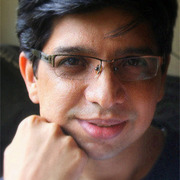Individual updates on MOOC status

Dr. Sameer S. Sahasrabudhe, IIT Bombay
Computer Science and Engineering
July, 2018 (I) By Dr. Veenita Shah
Dr. Sameer S. Sahasrabudhe is working as a Senior Project Research Scientist at IIT Bombay. Animation designer by profession, Dr. Sahasrabudhe offers Skill MOOCs through IIT BombayX, namely Basic 3D animation using Blender and 3D Architectural Visualization. He has also co-instructed several other MOOCs such as Foundation Program in ICT for Education, Pedagogy for Online and Blended Teaching-Learning Process, Communication Skills and Use of ICT in Education for Online and Blended Learning.
MOOCs have a larger impact with online access and no geographical boundaries. Dr. Sahasrabudhe’s experience with MOOCs is exclusive as his courses attract distinct audience. “Many learners take up my courses as an extra-curricular activity; however, they end up recognizing the application of knowledge in their day-to-day tasks. This in fact has been a learning experience for me in structuring the course in a way to benefit the participants in their curriculum and future,” he told.
“Modularization of MOOC into a short course (4-week) is always more engaging than a semester-long (12-week) course.”
MOOCs differs from the other online content in its very definition of a course, with defined objective, focused content and supportive assessment. Creating content is an integral part of any MOOC, even more, when we are dealing with skilled courses. Dr. Sahasrabudhe told, “It involves three key aspects to be considered: 1) correctness of the content, 2) incorporation of active learning principles in the course design, and 3) providing feedback on assessment. A battery of beta testers should be employed to review the content, and ensure the accuracy of content. Course activities should be designed in a way to maintain learners’ interest and engagement. Lastly, some kind of constructive feedback on assessment from the instructor provides a personal connect to learners.”
Dr. Sahasrabudhe described his continuous efforts with IITBombayX team in creation of content for better engagement of participants. “Our videos were not merely recording the face of the speaker with inserted slides. Instead, it was an interspersing of videos slides, the screen capture of the software, as well as the speaker, so that the learners do not lose out on the personal connect. Along with the content team at IITBombayX, we also exploited the modified versions of multiple choice questions, available at the edX platform, to provide something fresh to our learners.”
“We created city-based WhatsApp groups, which was more of a casual medium of interaction for the course.“
In Skill MOOCs such as animation and visualization courses, attempting a few quizzes, or deriving mathematical derivations is not enough to successful learning. Here, demonstration of learning is typically performed through projects, showcasing some artefacts. However, the hidden challenge in such cases lies in assessment. Dr. Sahasrabudhe shares, “In my courses, I designed activities and assignments, which provided learners the freedom to express themselves. However, since it involved visuals with so many variables, it was a huge challenge to assess them on such massive scale. This is one of the biggest obstacles in MOOCs, which can be well encountered by peer evaluation. It is the only mechanism, which can turn this challenge into an advantage.”
On his experience regarding instructor-paced vs. self-paced courses, Dr. Sahasrabudhe told, “I have been fortunate to have run one of my courses in both instructor-paced (2 offerings) and self-paced (3 offerings) mode involving blended learning. We observed that instructor-paced offering helped participants to progress at the same time, whereas the self-paced course provides flexibility to learners to learn at their own pace. Self-paced mode seems to be the best choice for non-curricular courses, to avoid additional burden and overlap with the college curriculum. However, it involves an extra effort from instructors and teaching assistants to simultaneously manage so many learners at different stages in the self-paced mode.”
MOOCs is thus an excellent resource for the academic domain offering learnings on updated technologies and skills, which is not possible always for academic institutes. MOOCs are thus being utilized by many institutes to benefit their students. Dr. Sahasrabudhe explains this usage and states, “Alignment of MOOC with the curriculum should be considered before it is used in the class. Some kind of activities such as reflection or assimilation quizzes should be conducted to examine the level of understanding for the students. My course videos are utilized in assignments in computer graphics by computer science colleges. Students who have taken my MOOC have also conducted Blender animation workshops in colleges. Thus, there are tremendous ways in which MOOCs can benefit.”
Online education is transforming access to knowledge. However, with this portability of knowledge, retention of learners becomes a challenge. Dr. Sahasrabudhe feels that MOOCs, in future, should ideally be customized to smaller target audience to have a larger impact rather than creating a generic content MOOC addressing larger audience, which suffers poor retention rates. “My course on animation needs to vary for students from different grades and universities in order to be beneficial. This marginal customization should be appreciated by MOOC instructors to cater to focused audience. Additionally, modularization of MOOC into a short course (4-week) is always more engaging than a semester-long (12-week) course. Availability of hardware with necessary internet connectivity is another big hurdle for many learners. Lack of appropriate accreditation for MOOCs also concerns the students in investing their time in these courses. Our visits to some of the remote centres made us realize that some of their own staff members were not aware that a MOOC is running in the next room. Thus, a team dedicated towards MOOC publicity, through various means such as social media or personal visits, is vital to benefit our cause to open online education,” he explained.
Reaching out to MOOC participants and connecting with them plays a critical role in their learning. Learners sometimes shy away from asking queries on discussion forums. Dr. Sahasrabudhe mentions some of the techniques used to help learners express themselves. “We created city-based WhatsApp groups, which was more of a casual medium of interaction for the course. Teaching assistants/beta testers/discussion forum moderators were part of a group each to moderate the discussions. We experienced higher interaction level as well as spontaneity from the students. We also created a Facebook page for our course, which was populated with submissions from the course. These could also be appreciated by family and friends of the participants. This led to many substantial new connections. We started with personalized focused emails, providing updates to students on their course status such as pending quizzes with details on incomplete questions. We have received positive feedback regarding these emails, which have helped many learners in completing their courses.”
MOOCs, in its own way, connect learners of the country with each other. Dr. Sahasrabudhe remembered an email from a student from one of the north eastern states in India, where the learner stated her joy to be a part of the country, and being connected with thousands of other learners in a LIVE course. Another participant from Jammu sent a thank you email to Dr. Sahasrabudhe for extending the assignment deadline for the course, which allowed her submission amidst a curfew imposed in the valley, due to disturbed political environment. “It gives me immense satisfaction as a MOOC instructor when such deserving people can participate, who have all the required potential, and just waiting for an opportunity to learn,” he concluded.




